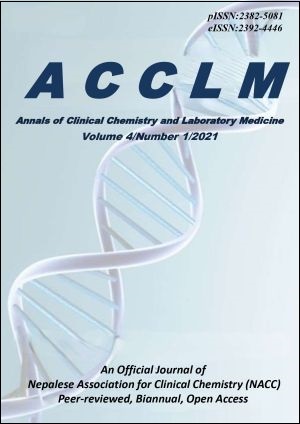Urinalysis: Extract the Relevant Information Before Throwing it into the Drain
DOI:
https://doi.org/10.3126/acclm.v4i1.42672Abstract
From ancient time urine has been considered as a substance of importance and examination for physical wellbeing. Evidences from the ancient civilizations including the Egyptian, Sumerian, Babylonian and Eastern Civilizations such as Vedic cultures support the use of urine as an index of physical and mental well-being. Classified as coloured, black, frothy, cloudy and sweet, urine used to be correlated with different disease conditions such as jaundice, kidney diseases, diabetes etc. These practices have been carried on even by the alchemists and have now formed as an integral constituent of clinical laboratory diagnostics.
Modern approach to urinalysis can be credited to Dr. Richard Bright, MD, who in 1827 by performing urine examinations related to vol-ume, colour, pH, protein (but not cast) corre-lated his findings to several diseases and clini-cal picture including edema, proteinuria etc.
Urinalysis combines the expertise from vari-ous disciplines including biochemistry, pa-thology, microbiology, cytology etc. Urinalysis may be used for screening, diagnosis, monitoring and prognosis due to the ease of collection in any settings. Modern day tech-niques such as molecular biology, immunolo-gy, and mass spectrometry with high resolu-tion microscopy have taken up urinalysis to explore the genetic predisposition to inherited diseases and tumor studies besides the routine diagnostics. So, variation occurs in urinalysis from the simple routine analysis, microscopic examination to highly sophisticated and ad-vanced automated analytical techniques. Uri-nalysis therefore, forms a key component of personalized medicine also integrating with proteomics, genomics, metabolomics approaches.
Downloads
Downloads
Published
How to Cite
Issue
Section
License
Copyright (c) 2021 Nepalese Association for Clinical Chemistry

This work is licensed under a Creative Commons Attribution-ShareAlike 4.0 International License.
Authors who publish with this journal agree to the following terms:
- The author transfers copyright to the Nepalese Association for Clinical Chemistry.
- The journal publishes the work under a Creative Commons Attribution License that allows others to share the work with an acknowledgement of the work's authorship and initial publication in this journal and under the same share-alike license used here.
- Authors are able to enter into separate, additional contractual arrangements for the non-exclusive distribution of the journal's published version of the work (e.g., post it to an institutional repository or publish it in a book), with an acknowledgement of its initial publication in this journal.
- Authors are permitted and encouraged to post their work online (e.g., in institutional repositories or on their website) prior to and during the submission process, as it can lead to productive exchanges, as well as earlier and greater citation of published work (See The Effect of Open Access).




